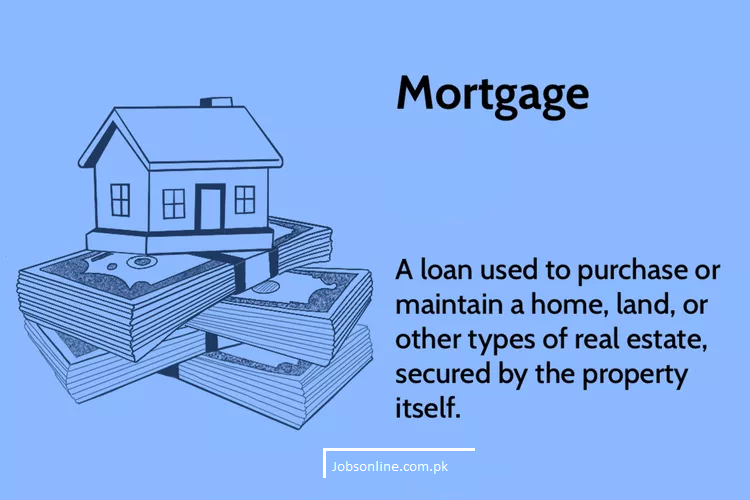A mortgage loan is a kind of credit used to buy or keep a home, land, or different sorts of land. The borrower consents to pay the moneylender over the long haul, ordinarily in a progression of standard installments separated into head and premium. The property then goes about as insurance to get the advance. A borrower should apply for a home loan through their favored moneylender and guarantee they meet a few prerequisites, including least FICO ratings and up front installments. Contract applications go through a thorough guaranteeing process prior to arriving at the last stage. Sorts of home loans change in view of the borrower’s requirements, for example, customary and fixed-rate advances.
[lwptoc]
KEY TAKEAWAYS
Contracts are credits used to buy homes and different kinds of property.
The actual property goes about as insurance for the credit.
Contracts are accessible in various kinds, including fixed rate and movable rate.
The cost of a home loan will rely upon the kind of credit, the term (like 30 years), and the financing cost the bank charges.
Contract rates can change generally contingent upon the sort of item and the candidate’s capabilities.

How Mortgages Work
Individuals and businesses use mortgages to purchase real estate without paying the full price. The borrower pays the loan plus a certain amount of interest until they own the property free and clear. Most conventional mortgages are fully forgivable. This means that the regular payment amount will remain the same, but different ratios of principal versus interest will be paid with each payment over the life of the loan. Typical mortgage terms are for 30 or 15 years.
A mortgage is also known as a lien or property claim against the property. If the borrower stops making mortgage payments, the lender can foreclose on the property.
For example, a residential home buyer mortgages their home to their lender, who then has a lien on the property. It ensures the lender’s interest in the property if the buyer defaults on his financial obligation. In the event of a foreclosure, the lender can evict the residents, sell the property, and use the proceeds from the sale to pay off the mortgage loan.
The Mortgage Process
Borrowers start the interaction by applying to at least one home loan moneylenders. The bank will request evidence that the borrower can reimburse the advance. This might incorporate bank and speculation proclamations, late assessment forms, and evidence of current work. The moneylender will for the most part run an acknowledge check too. In the event that the application is supported, the bank will offer the borrower a credit for a specific sum and at a specific loan fee. Home purchasers can apply for a home loan when they’ve picked a property to purchase or while they’re actually looking for it, an interaction called pre-endorsement. Being pre-supported for a home loan can give purchasers an edge in a tight real estate market since venders will realize they have the cash to back up their deal.
When the purchaser and merchant have settled on the provisions of their agreement, they or their agents will meet at what is called shutting. This is the point at which the borrower makes their initial investment to the bank. The vender will move responsibility for property to the purchaser and get the settled upon sum, and the purchaser will sign the remainder of the home loan archives. The moneylender might charge an expense (some of the time as focuses) for starting the credit toward the end.
Types of Mortgages
Contracts arrive in various structures. The most well-known types are 30-year and 15-year fixed-rate contracts. Some home loan terms are basically as short as five years, while others can run 40 years or longer. Extending installments over additional years might lessen the regularly scheduled installment, however it likewise expands the aggregate sum of interest that the borrower pays over the existence of the credit. Inside the different term lengths are various sorts of home advances, including Government Lodging Organization (FHA) credits, U.S. Division of Agribusiness (USDA) credits, and U.S. Division of Veterans Issues (VA) advances accessible for explicit populaces that might not have the pay, financial assessments, or initial installments expected to fit the bill for regular home loans.
Coming up next are only a couple of instances of probably the most famous kinds of home loan credits accessible to borrowers.
Fixed-Rate Mortgages
The standard kind of home loan is the proper rate. With a fixed-rate contract, the financing cost remains something very similar for the whole term of the credit, as does the borrower’s month to month contract installment. A proper rate contract is likewise called a regular home loan.
Adjustable-Rate Mortgage (ARM)
With a movable rate contract (ARM), the financing cost is fixed for an underlying period, after which it can change occasionally founded on current loan fees. The underlying financing cost is frequently a beneath market rate, which can make a home loan more reasonable temporarily however possibly more expensive in the long haul in the event that rates rise fundamentally.
ARMs regularly have cutoff points, or covers, on how much the financing cost can be changed each time and over the existence of the credit in general.
Interest only loans
Other, less common types of mortgages, such as interest-only mortgages and option-to-pay ARMs, can involve complex payment schedules and are best used by sophisticated borrowers. These types of loans can feature a large balloon payment at the end.
During the lodging air pocket of the mid 2000s, numerous property holders crossed paths with this kind of home loan.
Reverse Mortgage loan
As their name suggests, reverse mortgages are very different financial products. They are designed for homeowners age 62 and older who want to convert some of the equity in their homes into cash.
These mortgage holders can get against the worth of their home and get the cash as a singular amount, fixed regularly scheduled installments, or a credit extension.The entire loan balance becomes due when the borrower dies, moves away permanently, or sells the home.
Average Mortgage Rates (So Far for 2023)
How much you pay for a mortgage depends on the type of mortgage (such as fixed or adjustable), its term (such as 20 or 30 years), any discount points paid, and the current interest rate. is on Interest rates can vary from week to week and from lender to lender, so it pays to shop around.
Contract rates were close to keep lows in 2020, with rates on a 30-year fixed-rate contract averaging 2.66 percent for the seven day stretch of December 24, 2020.
Rates have remained consistently low all through 2021 and have begun to rise consistently from 3 December 2021 (see graph underneath). As indicated by the Government Home Credit Home loan Partnership, the typical financing cost as of September 2023 seems to be this:
- 30-year fixed-rate mortgage: 5.30%
- 15-year fixed-rate mortgage: 4.45%
- 5/1 adjustable-rate mortgage: 4.19%
How To Apply for a 5 Lakh Loan Without Interest In Pakistan 2023
How to Compare Mortgages
Banks, savings and loan associations, and credit unions were at one time virtually the only sources of mortgages. Today, a growing segment of the mortgage market includes non-bank lenders, such as Better, Loan Depot, Rocket Mortgage, and Sofi.
In the event that you’re looking for a home loan, a web-based contract number cruncher can assist you with contrasting assessed regularly scheduled installments, in light of the kind of home loan, financing cost, and how huge an initial installment you need. mean to It can likewise assist you with deciding how much costly property you can sensibly manage.
Notwithstanding the head and premium you’ll be paying on the home loan, the moneylender or home loan servicer may set up an escrow record to make good on nearby local charges, property holder’s insurance installments, and certain different costs. These expenses will add to your monthly mortgage payment.
Also, note that if you put down less than 20% when you take out your mortgage, your lender may require you to purchase private mortgage insurance (PMI), which is an additional monthly premium. becomes a cost.
The Bottom Line
Mortgages are an essential part of the home buying process for most borrowers who aren’t sitting on millions of dollars in cash to buy a property. There are different types of home loans available to suit your circumstances. Different government-supported programs assist more individuals with fitting the bill for home loans and make their fantasy of house purchasing a reality.
FAQs
Why do people need mortgages?
Home costs frequently surpass the sum most families save. Subsequently, contracts permit people and families to buy a home with just a moderately little initial investment, for example, 20% of the price tag, and a credit for the equilibrium. The advance is then gotten by the worth of the property in the event that the borrower defaults.
Can anybody get a mortgage loan?
Mortgage lenders will need to approve potential borrowers through an application and underwriting process. Home loans are only provided to people who have enough assets and income to match the debt to practically cover the value of the home over time. A person’s credit score is also evaluated while deciding to extend a mortgage. Interest rates on mortgages also vary, with riskier borrowers charging higher interest rates.
Mortgages are offered through various sources. Banks and credit unions often provide home loans. There are also specialized mortgage companies that deal only with home loans. You can likewise employ an unaffiliated home loan intermediary to assist you with looking for the best rate among various banks.
What does fixed vs. variable mean on a mortgage?
Many home loans have a proper financing cost. This implies that the rate won’t change for the whole term of the home loan — typically 15 or 30 years — regardless of whether financing costs rise or fall from here on out. A variable or customizable rate contract (ARM) has a financing cost that vacillates over the existence of the credit in view of loan fees.
How many mortgages can I have on my home?
Lenders usually issue a first or primary mortgage before allowing a second mortgage. This additional mortgage is commonly known as a home equity loan. Most lenders do not provide for subsequent mortgages backed by the same property. There is technically no limit to how many junior loans you can take out on your home as long as you have the equity, debt-to-income ratio, and credit score to get them approved.
Why it called a mortgage?
“Contract” comes from Early English and French, signifying “contract”. It gets its name since this kind of advance “passes on” when possibly it is settled completely or on the other hand assuming the borrower defaults.
